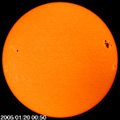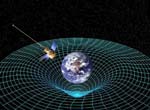WEEKLY UPDATE FOR 28 JANUARY 2005:
GRAVITY PROBE B MISSION STATUS AT A GLANCE
| Item | Current Status |
| Mission Elapsed Time | 283 days (40 weeks/9.25 months) |
| Current Orbit # | 4,178 as of 4:00 PM PST |
| Spacecraft General Health | Good |
| Roll Rate | Normal at 0.7742 rpm (77.5 seconds per revolution) |
| Gyro Suspension System (GSS) | All 4 gyros digitally suspended in science mode |
| Dewar Temperature | 1.82 kelvin, holding steady |
| Global Positioning System (GPS) lock | Greater than 96% |
| Attitude & Translation Control (ATC) | X-axis attitude error: 233.5 marcs rms |
| Command & Data Handling (CDH) | Multi-bit errors (MBE): 0 Single-bit errors (SBE): 8.5 (daily avg.) |
| Telescope Readout (TRE) | Nominal |
| SQUID Readouts (SRE) | Nominal |
| Gyro #1 rotor potential | -13.8 mV |
| Gyro #2 rotor potential | +9.2 mV |
| Gyro #4 rotor potential | -12.2 mV |
| Gyro #3 Drag-free Status | Backup Drag-free mode (normal) |
MISION DIRECTOR'S SUMMARY
As of Mission Day 283, the Gravity Probe B vehicle and payload are in good health, with all systems functioning nominally and nearly five months of science data collected. Last Thursday morning (20 January 2005), GP-B entered Safemode 2A (gyro hold), due to the loss of the guide star. Analysis of this safemode indicated that the telescope detectors were saturated by a large solar flare (X-7 class) that occurred Wednesday night. The solar flare had fluxes spiking several orders of magnitude above nominal in the > 100MeV proton energy range. Less than a day later (16:27 PST), GP-B successfully re-locked onto the guide star and the Attitude and Translation Control (ATC) system returned to its nominal configuration. During this event, the attitude error of the spacecraft and telescope remained within 800 arcseconds of the guide star. A preliminary assessment suggests that this event had minimal impact on the GP-B data or experiment.

One issue currently being investigated is the spacecraft’s proton monitor, which had been yielding spurious values before last week’s solar storm. The proton monitor was power cycled this Tuesday night (25 January). After reboot, it provided two hours of meaningless data followed by zeros. The proton monitor team is examining the data for additional clues, and a review of this issue will be forthcoming.
MISSION NEWS
Last week’s intense solar storm has died down, and solar proton activity, as reported by the National Oceanic & Atmospheric Administration’s (NOAA) Space Environment Center (SEC), has returned to normal levels. (The left solar photo and graph are from last week; the solar photo and graph on the right are from today.) Likewise, the GP-B spacecraft has returned to normal functioning, with the ATC system locking normally on the guide star each orbit and the telescope detectors returning normal values.
 GP-B was not the only satellite affected by last week’s solar storm; other satellites fared worse from the ordeal.
In fact, given that last week’s solar storm was the worst one since October, 2003, the GP-B spacecraft performed remarkably well, with a very swift recovery and no significant impact to the experiment.
GP-B was not the only satellite affected by last week’s solar storm; other satellites fared worse from the ordeal.
In fact, given that last week’s solar storm was the worst one since October, 2003, the GP-B spacecraft performed remarkably well, with a very swift recovery and no significant impact to the experiment.
PHOTO OF GP-B IN ORBIT FROM AMATEUR ASTRONOMER STEFANO SPOSETTI

Just before the holidays, Swiss amateur astronomer and physics teacher, Stefano Sposetti sent us two new photos of the GP-B spacecraft in orbit, one of which is shown to the right. In this photo, taken on 6 December 2004 (during the spacecraft’s full-sun season), Mr. Sposetti used a 20mm f2.8 photo lens, coupled with a CCD camera on a fixed tripod, with a 60-second exposure to capture a beautiful time exposure of the GP-B spacecraft, rising over a rooftop. You can view other astronomical photos taken by Mr. Sposetti, including photos of the GP-B spacecraft on Mr. Sposetti’s Web page in the Astronomical Image Data Archive (AIDA). As always, we are most grateful to Mr. Sposetti for sending us this extraordinary photo.
THE EINSTEIN EXHIBITION AT THE SKIRBALL CULTRAL CENTER IN LOS ANGELES
 If you're going to be in Los Angeles anytime before 30 May 2005, and if you’re interested in Einstein’s life and work, the Einstein Exhibition at the Skirball Cultural Center (just north of the Getty Museum on Interstate 405) is the most comprehensive presentation ever mounted on the life and theories of Albert Einstein (1879-1955). It explores his legacy not only as a scientific genius who re-configured our concepts of space and time, but also as a complex man engaged in the social and political issues of his era. It examines the phenomenon of his fame and his enduring status as a global icon whose likeness has become virtually synonymous with genius.
If you're going to be in Los Angeles anytime before 30 May 2005, and if you’re interested in Einstein’s life and work, the Einstein Exhibition at the Skirball Cultural Center (just north of the Getty Museum on Interstate 405) is the most comprehensive presentation ever mounted on the life and theories of Albert Einstein (1879-1955). It explores his legacy not only as a scientific genius who re-configured our concepts of space and time, but also as a complex man engaged in the social and political issues of his era. It examines the phenomenon of his fame and his enduring status as a global icon whose likeness has become virtually synonymous with genius.
In this exhibit, you can examine Einstein's report card, inspect his FBI file, and enjoy his family photographs, love letters, and diary entries. Exhibition highlights include scientific manuscripts and original correspondence—including original handwritten pages from the 1912 manuscripts of the special theory of relativity and his 1939 letter to President Roosevelt about nuclear power—and a wealth of other documents from the Albert Einstein Archives at the Hebrew University of Jerusalem.



In addition to these displays of Einstein memorabilia, the exhibit also features a number of interactive components that help provide an understanding of Einstein's revolutionary theories. Furthermore, several “explainers,” identified by their red aprons, are on hand to discuss various aspects of the exhibit and to explain and demonstrate difficult concepts, such as time dilation and warped spacetime. At the end of the exhibit, you’ll find one of GP-B’s gyro rotors on display.
The Einstein exhibition was jointly organized by the American Museum of Natural History (AMNH), the Hebrew University of Jerusalem, and the Skirball Cultural Center. It was designed by the AMNH under the supervision of Dr. Michael Shara, curator of the exhibit and chairman of the museum’s Astrophysics Department. It opened in November 2002 at the AMNH in New York and then traveled to Chicago and Boston, spending about 8 months in each location. It will remain at its final U.S. stop at the Skirball Center in Los Angeles through 29 May 2005, after which time it will move permanently to the Hebrew University in Jerusalem.
Information about the Einstein exhibition is available on the Skirball Center Web site. If you can’t make it to Los Angeles, you can visit the AMNH’s virtual Einstein exhibit on the Web.
Drawing, photos, and charts: GP-B Public Affiars Coordinator, Bob Kahn, created the composite photo of the GP-B spacecraft in orbit. The photos of solar flares and sun spots were taken from the NASA/ESA SOHO Web site. The charts showing the elevated levels of proton activity are from the NOAA Web site. The photos from the Einstein Exhibit are courtesy of the Skirball Cultural Center. Click on the thumbnails to view these images at full size.
MORE LINKS ON RECENT TOPICS
- Track the satellite in the sky
- Photo, video & and news links
- Build a paper model of the GP-B Spacecraft
- Following the mission online
- Our mailing list - receive the weekly highlights via email
- The GP-B Launch Companion in Adobe Acrobat PDF format. Please note: this file is 1.6 MB, so it may take awhile to download if you have a slow Internet connection.
Previous Highlight
Index of Highlights

